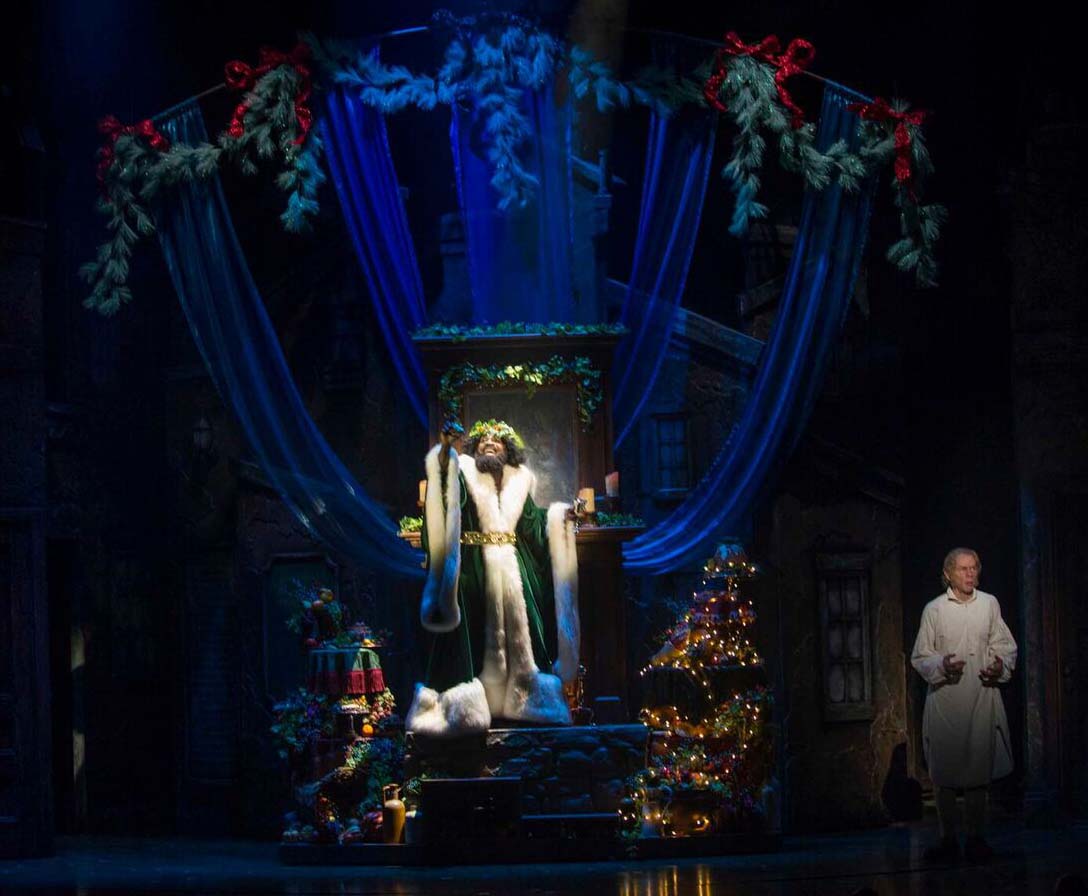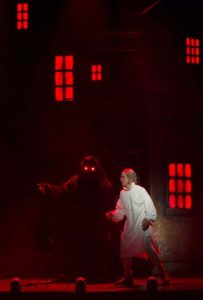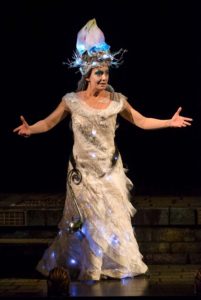
by Jeff Grygny
The Rep’s A Christmas Carol at the Pabst Theater is a Milwaukee tradition, and it’s easy to understand why. In the glittering, mildly haunted confines of that venerable venue, Charles Dickens’ old story of ghosts and redemption can become enchanting, beloved, timeless, and all the other adjectives marketing people like to trot out for the holidays. But the show presents peculiar problems for a theater company: while a reliable source of much-needed revenue, after forty years of “Bah, humbug!” and “God bless us everyone,” how do you keep it from becoming a tiresome cliché?
If there is any magic in theater, it’s the illusion of the first time; telling a story in such a full and heartfelt way that it seems to be happening right now. Happily, the cast of A Christmas Carol pulls this off with great exuberance and good cheer. That alone would be enough—but there’s more. Under the leadership of Artistic Director Mark Clements, the show has undergone a total makeover, with brand new scenery, high-tech effects, music, script, and a few other innovations that might raise a traditionalist’s eyebrows. Not everything works; Clements will probably want to do some re-tooling before next year. But overall, in the company’s very professional hands, the story wonderfully summons the glow of good will and generosity that made it great when Dickens first published it more than a century ago.

If the elaborate stagecraft looks like a million dollars, that’s because it cost that much—as the first-night crowd of Rep bigwigs and wealthy patrons knew better than anyone. They need notfear their investment was wasted. True, the production sometimes feels like one of the fancy gewgaws in of the Hammacher Schlemmer catalog: a high-tech amusement for privileged children. But it’s undoubtedly impressive; the storybook walls of Todd Edward Ivins’ set churn like the gears of the Industrial Revolution to reveal scores of city windows glowing over the action below. Scenes open in a bluish light that recalls old photographs of figures in exquisite compositions, just before they come to life. Spirits pop out of walls and the floor, and vanish back there again. Snow falls picturesquely over our heads. True, the Spirit of Christmas Future, with his (her?) oversized hood and glowing red eyes, does sort of resemble a large Jawa out of Star Wars. But the show is really directed toward children; Marley’s somewhat cartoonish appearance will startle them, but will probably cause fewer nightmares than the grown-up version.

Despite having to work with moving floors and complex technical cues, the cast brings their best game to John Tanner’s musical arrangements that blend atmospheric incidental music with traditional carols, full of feeling without being overly sentimental, all delivered with gusto and in lovely harmonies. It’s hard to overstate Michael Pink’s contribution to the many dances and group movement scenes: the Milwaukee Ballet Director is a master of showing emotional moments through movement; even the stage fog seems to swirl in meaningful patterns. It’s heartbreaking to watch Scrooge address figures from his past, only to realize, with him, that they’re only phantoms.

Jonathan Wainwright is an intriguing choice for the role of Ebenezer Scrooge; in the past he’s played Bob Cratchit, and his youthful, open face seems most un-miserly. But he’s a shape-shifter who virtually disappears into a secondary role as Charles Dickens, and when he scrooges his face into a misanthopist’s scowl, he’s totally credible. His Scrooge is clearly a wounded soul who’s defensive turning away from human contact has hardened him into the monster he’s become—making him more sympathetic to, say, a younger audience.
A cornucopia of talented players supports Wainwright on his journey. For Dickens, the important thing was not to show characters who are complex and conflicted, but rather as we should be; the actor’s job is to not come off as maudlin. As Scrooge’s nephew, Michael Doherty’s goodwill seems genuine and unforced. Christie Coran and Jessie Hooks bring tremendous charm to the roles of the two women in Scrooge’s life, while Reese Madigan makes for a suitably stalwart Bob Cratchit.
Chike Johnson delivers a rich West Indies version of the Spirit of Christmas present, whose emphatic “all the people” takes on particular resonance. Angela Iannone brings her wit and authority to several parts. Some Rep favorites make the most of tasty minor roles (I want a whole play about Jonathan Smoots’ Old Joe): Jonathan Gillard Daly shakes a plump leg as Fezziwig; Deborah Staples does her best Cate Blanchett-as-Galadriel impression in a dramatic moment as the Spirit of Christmas Past. And if we wince at the off-notes in Tiny Tim’s solo, it’s quite a short song, and little Edward Owczarski makes up for it in sheer cuteness.

The first act is the more enchanting, taking good time to work its magic. Act Two seems a bit rushed, with the story ending suddenly in exposition. Wainwright’s double role as Dickens is a nice idea, but confusing: the costume changes necessitate lengthy diversions that don’t drive the story, while it’s just weird for the Scrooge we’ve come to like disappears for the curtain call to be replaced by a character we’ve hardly seen. Another innovation whose mileage may vary is Clements’ addition of “Panto” elements This venerable English holiday tradition includes audience participation in the context of slapstick, topical jokes, silly songs, and drag. To transplant just the audience participation part seems jarring—but the youngest members of the audience likely won’t mind at all. Having the characters talk to the audience also prepares us for the show’s biggest departure from tradition: a direct fundraising pitch from the players for the Boys and Girls Club of America. In a way, this makes perfect sense: after all it’s a play about charity—why not let the audience take an active part? On the other hand, framed within the story, and not after the curtain call as would be customary, it could be a major mood-breaker for many people.
Artists throughout history have labored to cajole powerful men to show mercy and kindness to lesser folk. As long as chasms remain in society, shows like A Christmas Carol, with its penetrating look into poverty, tragedy, and cruelty will, alas, remain timely.
Milwaukee Repertory Theater presents
A Christmas Carol
by Charles Dickens
adapted and Directed by Mark Clements
Playing through December 24th
